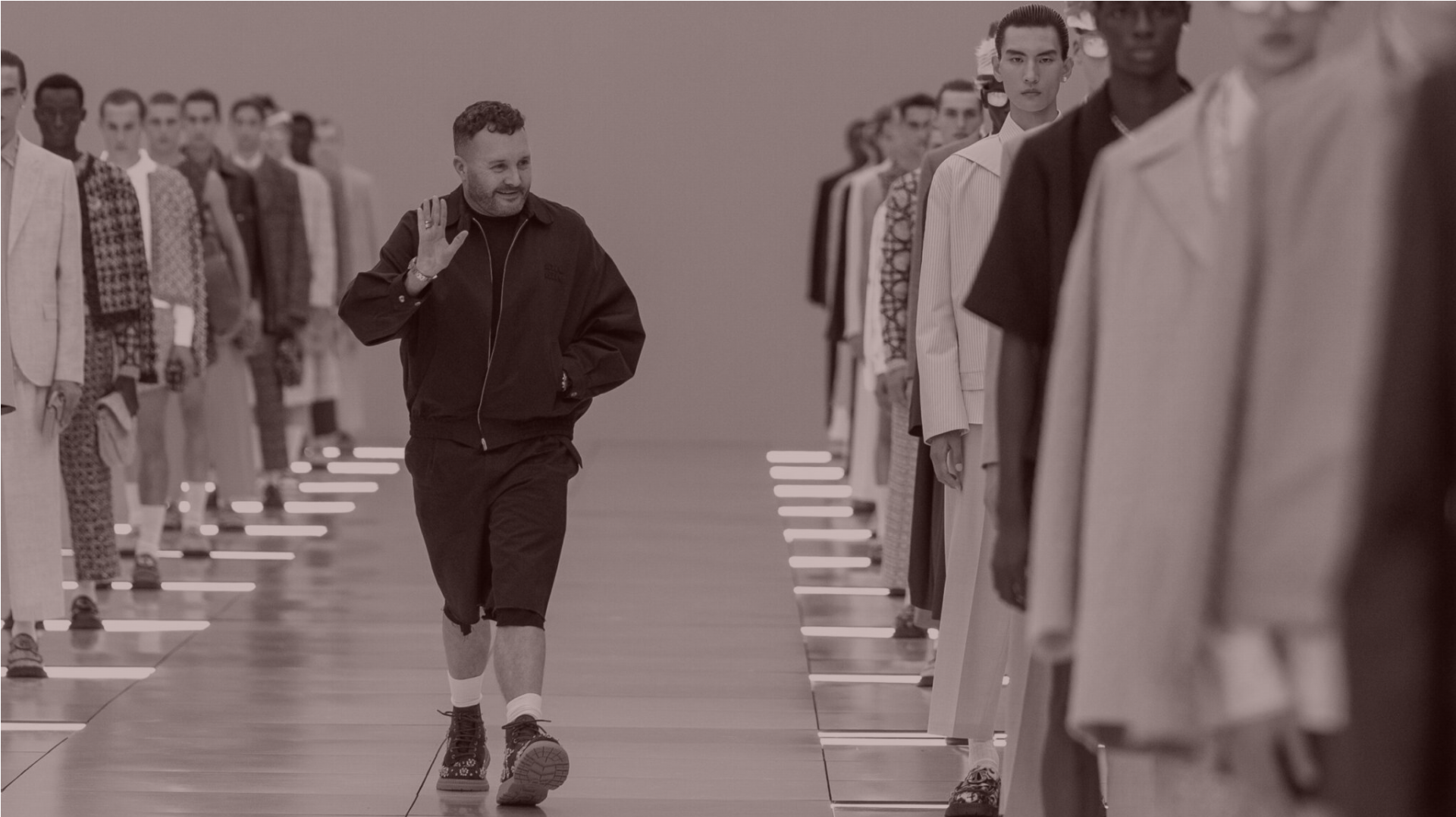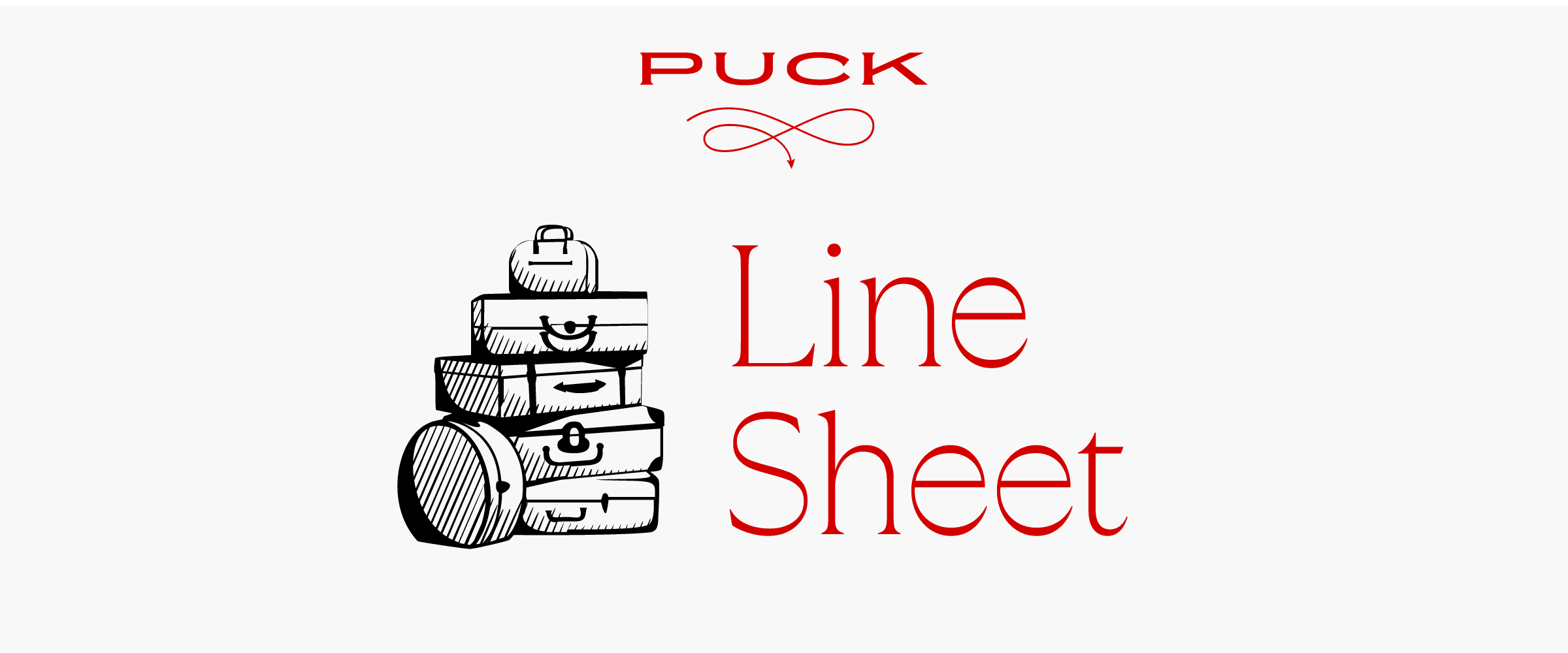|
|
Hi, welcome to Line Sheet. This week, I’m back in Los Angeles for the next leg of book promo and some Puck stuff. Feeling a teeny bit regretful that I’m not in New York, given everything that’s going on, including Tuesday’s much-hyped Victoria’s Secret runway show return (there are going to be lots of good models, including Kate Moss) and the giant Giorgio Armani to-do on Thursday. Don’t worry, I’ll be watching both from afar. Send me insights and intel to help inform my coverage.
For today’s main event, there’s a critical reading of the Kim Jones-leaving-Fendi press release. Also, some quick-hit analysis of stories I chose not to touch last week, plus new-old news from Condé Nast and its ever-embroiled H.R. department (hi, Stan) and an examination of Blake Lively and Taylor Swift’s latest fashion offenses. Finally, Rachel “[email protected]” Strugatz is here with a crucial Violet Grey update.
🎧 Programming notes: Tomorrow on Fashion People, I’m joined by my bud Marisa Meltzer. We’re talking about everything above and more. Listen here and here. I’m also on tomorrow’s episode of The Powers That Be with Peter Hamby discussing Selling Sexy, which I’ve also been promoting on The Run-Through With Vogue, and How Long Gone.
⏰ Just a reminder, for those in Los Angeles: On Wednesday, October 16, I’ll be at Skylight Books in Los Feliz with my co-author Chantal Fernandez, talking to Hillary Kerr about Selling Sexy. There will be Las Jaras wine. RSVP here. It’s free.
Mentioned in this issue: Fendi, Kim Jones, Pierpaolo Piccioli, Jonathan Anderson, LVMH, Bernard Arnault, Violet Grey, Sarah Brown, Condé Nast, Vogue, Anna Wintour, Roger Lynch, Semafor, Blake Lively, Taylor Swift, Hodinkee, Dior, Loewe, and many more…
|
| Three Things You Should Know… |
|
- A recounting of poor management: Yesterday, Semafor’s Max Tani ran a pretty in-depth depiction of the “Gaza infighting roiling Condé Nast,” detailing the exit of D.E.I. chief Yashica Olden after she was accused by employees of antisemitism. In particular, many Jewish employees felt that she did not take seriously their pleas to create a resource group after October 7. (I reported on Olden’s resignation back in July, less than a month after she quit.) Tani’s piece covers stuff that happened months ago, including an email sent by Vogue entertainment director Sergio Kletnoy to Anna Wintour, Roger Lynch, and human resources head and fashion-show-lover Stan Duncan criticizing Teen Vogue’s coverage of Gaza. (Tani also mentioned the Gabriella Karefa-Johnson hullabaloo.)
I walked through Tani’s reporting with a couple of sources and was able to confirm what I didn’t already know pretty quickly. “The Yashica stuff is unfortunately true,” one person said regarding the complaints against Olden. What’s more, her exit was hush-hush: “They barely even told anyone,” this person said, suggesting that Duncan and other senior staffers were trying to paper over the situation. It’s also true that Pam Drucker Mann, the since-departed chief of revenue, pushed the company to make a statement regarding the attacks, which it eventually did, although most Jewish staffers felt it was insufficient.
Of course, the Condé Nast situation is extremely similar to what went down at Hearst around the same time. Almost all companies have a challenging time messaging their views during geopolitical crises—a new requirement in corporate life, to be sure. And October 7 provided a particularly complex set of variables—a horrific terror attack followed by a profound and sustained use of force (that, as my partner Julia Ioffe has noted, has been subject to scrutiny at The Hague), all of which prompted a uniquely explosive political schism. Indeed, those tensions are playing out in consequential ways within the Democratic Party right now, particularly in the critical swing state of Michigan. But I digress…
As for why Semafor decided to run this piece now? Perhaps Tani had been sitting on this for a while and viewed the Tony and Ta-Nehisi micro-controversy and one-year anniversary of the October 7 attacks as appropriate pegs. Perhaps everything that’s going on spurred a source to reach out. Regardless, what’s happening at Condé now? Feel free to D.M. me on social, reply to this email, or text me to discuss. Yes, I’m on Signal.
- The bad-fashion alliance: What are Blake Lively and Taylor Swift trying to prove with their latest date-night outfits? My D.M.s were flooded over the weekend with requests to cover Lively’s ripped stockings (how), Swift’s mishandling of her Dior saddle bag (“She can’t even hold a purse correctly,” one person commented), and their partners’ almost-as-offensive getups. Did the guys coordinate those White Lotus-meets-league bowling night looks?
I’m not the fashion police, but I am the brand-building police, so let me move this conversation away from whether or not the outfits were good and instead assess whether or not they were effective. The answer, of course, is yes. Lively and Swift continue to get under our skin. Taking taste out of the equation, it’s undeniable that they are conventionally attractive in every way, and their combined efforts not only reinforce traditional beauty standards, but also their identities as celebrities. The difference between the two of them, in my mind, is that Lively has zero self-awareness while Swift is too self-aware. It’s unclear to me whether, long term, this bad-fashion alliance will begin to alienate their core audiences. That’s a question for Tree Paine and Ryan Reynolds.
- Now, here’s Rachel with the latest twist in our favorite niche-beauty drama: It’s only been about a month since Cassandra Grey bought back Violet Grey with the help of investor Sherif Guirgis from 888 Midas Partners, and there are already major personnel changes afoot. I’m told that Sarah Brown, Grey’s right hand for nearly three and a half years, was laid off last week. “Brown has decided to leave the company to pursue other opportunities,” a spokesperson for Violet Grey told me.
Anyone who’s worked in beauty, and is over the age of 35, knows Brown from her time at Vogue, where her reign as beauty director spanned 13 years, back when print beauty directors were treated like actual celebrities and there was no such thing as Instagram. She joined Violet Grey in 2021, first as an executive director and then as chief brand officer, overseeing basically everything from content and conceptualizing campaigns to brand partnerships and marketing. Now, said an insider with knowledge of the retailer’s business, “They will lose any and all brands there.”
That may be overstating things, but my understanding is that Violet Grey already had a skeleton staff and Brown was the most experienced on the team. Alas, Brown was likely very expensive, and these new investors seem to be trying to save a buck wherever they can. —Rachel Strugatz
|
| I Was So Busy Last Week That I Forgot to Say… |
|
- Watch enthusiast site Hodinkee selling to British retailer Watches of Switzerland is probably not great for all the high-profile investors (LVMH Ventures, The Chernin Group) that poured money into the thing in 2020. The valuation wasn’t disclosed—another bad sign. Founder Ben Clymer’s promise that the content would directly feed commerce ended up being hopeful and misguided. (Doesn’t work like that, especially on the high end.) But he wasn’t wrong about the enduring appeal of high-end watches, or the broadening profile of collectors. If retailers consider content as additive, and don’t rely on it as a direct conversion tool, it can be powerful in a softer way.
- Yes, I have an opinion on the Met’s 2025 Costume Institute exhibition title and theme, “Superfine: Tailoring Black Style,” based on the 2009 book by Monica L. Miller, Slaves to Fashion: Black Dandyism and the Styling of Black Diasporic Identity. Miller will co-curate the exhibit alongside Andrew Bolton. (It’s worth reading Robin Givhan’s write-up for context.)
It seems like the Met, Bolton, and Wintour are handling this appropriately—offering Miller an active role and making the gala theme and exhibition theme uniform. (Usually they are slightly different, which can be unnecessarily confusing.) Of course, I fear how white attendees could interpret their mandate. That said, good art requires risk, and if public institutions (like the Met) or private ones (like Condé Nast) don’t take risks, the world will continue to shrivel into nothingness. Finally, this could be a huge marketing and advertising opportunity for GQ, too, as I am sure everyone involved is well aware.
|
 |
| The Piccioli-Jonathan-Jones Designer Dominoes |
| The much-delayed and already-obvious news that Kim Jones is leaving Fendi, almost certainly to be succeeded by Pierpaolo Piccioli, looks poised to finally (finally!) set off a chain reaction of designer moves of the first and second order. |
|
|
|
| A famous behind-the-scenes fashion person messaged me early on Sunday morning with a modest plea: Don’t forget about us. This person was gesturing toward a simple, unpleasant reality of the business. When a creative director steps down from a brand, as Kim Jones officially did from Fendi on Friday, a whole team often follows them out the door—designers, stylists, photographers, art directors, etcetera. The incoming creative director often interviews the internal design team and keeps only a few specialists in select roles, replacing the rest with loyalists from their previous stomping grounds.
These migratory patterns occur in most corporate and creative structures. The challenge with fashion, of course, is that creative director gigs are very limited, and a principal might be out of work for three, four, five years… or sometimes never work again. While the designers bear the brunt of the public scrutiny—people have been speculating about Jones’s exit from Fendi for more than a year—they are paid handsomely for their troubles, often high seven figures or even up to ~$15 million a year for truly exceptional talents. These people also have gardening leaves and Goldman Wealth accounts paying out 5 percent per year. Their teams, of course, do not… and they often cannot afford to take time off. (At least Jones still has his Dior menswear gig—many of his closest collaborators will be able to count on that.)
So now, given Jones’s exit and the natural order of things, another displaced team will be given a new home. Pierpaolo Piccioli’s appointment at Fendi is an open secret at this point; a rare near-inevitability in this industry. A funny twist would be if LVMH actually appointed Maria Grazia Chiuri instead—after all, the current Dior womenswear designer (and Piccioli’s former Valentino co-designer) is Roman, and there’s been speculation for years that she’d like to live full-time in Italy. WWD is reporting that Fendi is still interviewing potential replacements, including Piccioli, but that seems unlikely—Jones’s exit was not sudden. Everything tells me this one is going to Piccioli.
Anyway, all this bodes well for Pierpaolo’s inner circle. When he was ousted from Valentino earlier this year, much of his team was swiftly replaced by Alessandro Michele’s cohort, some of whom had stayed at Gucci when he exited in 2022, but many of whom had also dispersed.
Whoever replaces Jones will have their hands full. Fendi, which now battles with Celine for third place in the LVMH fashion rankings (below Louis Vuitton and Dior), is difficult to change because of its complex “creative configuration,” as the press releases often refer to the reporting structure. Family member Silvia Venturini Fendi remains head of menswear and accessories; her daughter, Delfina Delettrez Fendi, designs the jewelry. They are not leaving willingly, and almost definitely not until after the company’s 100th anniversary in 2025.
Perhaps Piccioli has been promised that there will be a change after next year. Or perhaps he’ll be happy enough to land a prestigious gig so shortly after his semi-surprising removal from Valentino. He is a gifted couturier, and knows how to make beautiful dresses that wealthy women are thrilled to buy. But he also needs to improve the handbags, the brand’s calling card, without actually overseeing that department. (Jones, a skilled merchandiser, tried his best to frame the bags in a more modern way with his wares, but the support obviously wasn’t there.)
Piccioli will also need to reckon with the fact the house is a furrier that can’t show fur, or even make a lot of it. (Anti-fur activists used to leave companies like Fendi alone because they believed it was easier to target those that were not grounded in the trade. That’s changed over the past decade.) There’s a chance Piccioli will move his studio from Rome to Milan in order to attract younger talent, but even if he gets everything he needs to make it work—control of the entire brand, resources, executive team support—it’s not going to be easy.
|
|
|
| As for Jones, LVMH made it very clear (with a statement from Bernard Arnault, himself) that the intention is for him to stay put at Dior. After all, he has transformed the megabrand’s menswear business from virtually nothing into a $3 billion juggernaut, according to certain estimates.
What does this mean for all the Jonathan Anderson-going-to-Dior speculation? I’ve been told, time and again, by people close to Anderson that the Loewe creative director is not interested in taking on a brand with a dual-designer structure. When has that truly worked for a visionary, like Anderson? After a designer reaches certain creative heights, complete control is the ultimate reward, and it’s often a requirement, too. What people say and what people do, though, are two different things. Could the LVMH brass convince him that designing womenswear at Dior is a big enough job?
Like many designers, Anderson is indebted to LVMH—literally. The J.W. Anderson filings on the British business registrar demonstrate that the U.K.-based brand operates at a loss. If Anderson were to leave the group, he’d probably have to find a buyer for his namesake brand at a multiple that would satisfy Arnault and his M&A team. There is a reason multiple sources, on both sides, told me earlier this year that Anderson had discussed an acquisition with Fast Retailing, the parent company of Uniqlo. Since then, I’ve heard of other fundraising efforts by his team at J.W.A. (At the time of my previous story, a rep for the company denied that there was any interest in breaking ties with LVMH.)
Of course, there is a chance that he did find a buyer for J.W.A. and that he plans on taking a big role at a brand not owned by the group, and is breaking out of what many people like to jokingly call LVMH jail. Or that he will take over for Chiuri at Dior in the womenswear department. There is also a chance that he will get Dior women’s and men’s, a year or so from now. But none of this needs to happen for Anderson to remain in a position of power. Arnault may see that Loewe is nowhere near its peak, and perhaps it is best to keep Anderson there after all.
At the moment, Loewe is the only 100 percent LVMH-owned brand that excites cool kids in an era when product integrity outweighs marketing with consumers. You can no longer fool them with flashy runway shows, augmented celebrities, and airbrushed advertisements. And Anderson knows that better than anyone.
|
|
|
| As I mentioned a few weeks back, the next big diet trend is making sure you are getting enough fiber on top of all the protein and fat you need to eat. (Consensus is still that sugar is the devil that conjured Ozempic to life.) David, a chic-looking, zero-sugar protein bar from one of the founders of Rx, is trying to make it easier to consume the daily requirements in a tight little 150-calorie package. Worth checking out this piece on the protein-bar arms race. [The Information]
Jacob is having fun ticking people off with his $910 fleece! (My friend Tina Chai also loves this brand Rier, by the way.) [NYT]
Dolev Elron won the grand prize at Hyères, unequivocally the most fun of the fashion prizes. [WWD]
Oops! B.A.’s email was accidentally shared by the U.K. government. [Politico]
It’s clear to me (and you) that a fashion magazine cover has zero influence on undecided voters, but I agree with Rachel Tashjian that Vogue’s latest Kamala feature was well-executed. [The Washington Post]
We’re all looking for new sneakers. Becky is here to help. [5 Things You Should Buy]
Loved this history of 1987’s Sonomama Sonomama and also the intel about the online vintage shop named after the book. [Blackbird Spyplane]
Sukeban went to London. [Wrestling News Source]
|
|
|
| And finally… the food in New York is too good.
Until Wednesday,
Lauren
|
|
|
|
| FOUR STORIES WE’RE TALKING ABOUT |
 |
| CBS News Blues |
| Charting a pair of micro-scandals plaguing Wendy McMahon. |
| DYLAN BYERS |
|
 |
| London Calling |
| Rounding up the essential art market chatter from Frieze. |
| MARION MANEKER |
|
 |
| Harris Hysteria |
| On the election anxieties rippling through the Democratic Party. |
| JOHN HEILEMANN |
|
 |
|
|
|
|
|
 |
|
|
|
Need help? Review our FAQs
page or contact
us for assistance. For brand partnerships, email [email protected].
|
|
You received this email because you signed up to receive emails from Puck, or as part of your Puck account associated with . To stop receiving this newsletter and/or manage all your email preferences, click here.
|
|
Puck is published by Heat Media LLC. 227 W 17th St New York, NY 10011.
|
|
|
|

